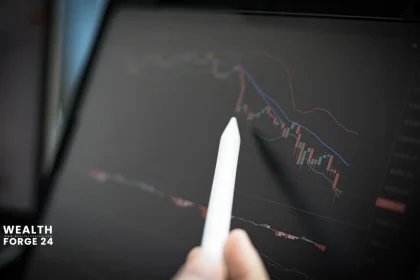Understanding Currency Correlation Concept
Currency correlation shows how currency pairs move in the forex market. They can move together, in opposite ways, or randomly.
This correlation is shown by a coefficient from -1 to +1. It’s a strong tool for understanding market dynamics and managing risks better. Understanding correlations can boost trading strategies. It helps avoid losing trades, hedge against risks, and diversify financial portfolios.
Currency correlation in trading shows how currency pairs move together. They can move in the same direction, in opposite directions, or randomly over time.
When you trade currencies, remember they come in pairs. No currency pair works alone; they all affect each other. As mentioned, correlation is calculated using what is known as the correlation coefficient, which ranges between -1 and +1. By taking these correlations into account, you can make smarter and more informed trading decisions.
Simplified Guide to Interpreting Different Correlation Coefficient Values
| Value | Meaning |
|---|---|
| -1.0 | Perfect negative correlation |
| -0.8 | Very strong negative correlation |
| -0.6 | Strong negative correlation |
| -0.4 | Moderate negative correlation |
| -0.2 | Weak negative correlation |
| 0 | No correlation. Completely random |
| 0.2 | Very weak and insignificant correlation |
| 0.4 | Weak correlation |
| 0.6 | Moderate correlation |
| 0.8 | Strong correlation |
| 1.0 | Perfect correlation |
Why Understanding Currency Correlations Improves Your Trading
Now that you understand currency correlation and chart reading, you might ask how it can boost your trading success.
Why do you need to get this important skill and add it to your tools as a trader?
A deep understanding of currency correlations greatly improves risk management.
If you trade many currency pairs at the same time, watch out. If those pairs are closely linked, you might face high risks. This could happen whether the links are positive or negative, and you may not even realize it.
Buying EUR/USD (Euro/US Dollar) and GBP/USD (British Pound/US Dollar) together raises your exposure. When these pairs are strongly correlated, you face double the same market risks.
You can improve your trades by looking at correlations. This helps you spread out risk, so you reduce the chances of big losses from one market event.
Five More Reasons Why Considering Currency Correlations Enhances Your Trading Strategy
1. Eliminating Unprofitable Trading
Using currency correlations can help you avoid opening positions that offset each other. The EUR/USD and USD/CHF pairs often move in opposite directions. This happens at a rate close to 100%, as we discussed in earlier lessons. Opening a buy position on EUR/USD and another on USD/CHF at the same time is unprofitable and can even be costly. You’ll pay the spread cost twice. If the price moves, one pair goes up while the other goes down. This means you won’t make any progress. Our efforts should have a tangible impact and a fruitful result!
2. Increasing Profits Using Leverage
Using leverage can double your positions, which may lead to bigger profits or losses. For example, if we examine the EUR/USD and GBP/USD pairs over a week, we see a strong positive correlation. The GBP/USD moves closely behind the EUR/USD. Opening a buy position for each pair would be like doubling your position on EUR/USD, meaning you are using leverage in a doubled manner. The results could be significant profits if things go correctly or large losses if things go against your expectations!
Knowing how currency pairs relate can help you spot when correlations break. This often happens due to unusual market conditions. These breaks can create chances to take advantage of price differences. They also let you exploit inconsistent pricing between related pairs.
If EUR/USD and GBP/USD usually move together but diverge because of an event in the UK, you can take advantage of this. You can open positions, betting that the two pairs will realign and move together again.
3. Better Risk Diversification
Understanding currency correlations helps you use various currency pairs. This diversifies your trades while you still benefit from your market analysis. You don’t have to rely on just one currency pair. You can reduce your risks by trading two pairs that move together. Choose pairs with strong correlation (close to 0.7). For example, EUR/USD and GBP/USD pairs often move together. However, this connection isn’t perfect. So, it offers a chance for diversification and helps reduce risk.
For example, if you expect the US dollar to rise, instead of opening two sell positions on EUR/USD only, you can sell EUR/USD and GBP/USD together. This approach can protect you from some risks and diversify your positions. In case the US dollar declines, the euro may be affected less than the British pound, reducing the size of your potential losses.
4. Hedge Risk
Hedging is a strategy traders use to guard against losses. They do this by opening an opposite position in a related currency pair.
When you understand currency correlations well, you can implement more effective hedging strategies.
Although hedging may lead to smaller profits, it is a powerful means of reducing losses.
If you buy EUR/USD and the price goes down, you can open a small buy on USD/CHF, which moves the other way. This way, you have avoided large losses!
Also, one of the advantages you can benefit from is the difference in pip values between different currency pairs.
For example, while there is an almost perfect negative correlation between EUR/USD and USD/CHF (at -1.0), the pip value for each is different.
If you are trading with a mini lot size (10,000 units), one pip in EUR/USD equals $1, while one pip in USD/CHF equals $0.93.
Let’s assume you bought one mini lot of EUR/USD; you can hedge by buying one mini lot of USD/CHF. If EUR/USD drops by 10 pips, your loss will be $10. But at the same time, the profit from trading in the USD/CHF position will be about $9.30.
Instead of your loss being a full $10, your actual loss will be only $0.70!
Hedging seems like the best solution, but it has some downsides, especially for the trading broker.
For example, if EUR/USD rises after hedging, your profits will be limited because your USD/CHF position will experience a loss.
Also, the correlation between pairs may weaken at any moment. Imagine that EUR/USD dropped by 10 pips, but USD/CHF only rose by 5 pips, remained stable, or even dropped!
In this case, your account may be exposed to very large losses.
Therefore, it is essential to be careful when using hedging strategies!
5. Confirming Breakouts and Avoiding False Breakouts
You can also use currency correlations to confirm entry or exit signals for a trade.
For example, if the EUR/USD pair is testing an important support level, and you notice price action and plan to sell if a downward breakout occurs.
You know that EUR/USD moves up with GBP/USD but down with USD/CHF and USD/JPY. So, you can see if these three pairs are moving as strongly as EUR/USD.
If GBP/USD is near an important support level and USD/CHF and USD/JPY are at strong resistance levels, it signals potential movement in the US dollar. This may suggest a breakout for EUR/USD, as its correlated pairs are moving similarly. So, you can decide to trade when the breakout occurs.
However, if the other three pairs are not moving with the same strength as the EUR/USD.
If GBP/USD stays stable, USD/JPY doesn’t rise, and USD/CHF is flat, then the drop in EUR/USD might be due to bad news about the European Union, not the U.S. dollar.
The price might drop below the support level you were watching. However, since other related pairs didn’t move the same way, like against commodities, it’s likely the price won’t keep going down. Instead, it may bounce back above the support level, creating a false breakout.
If you want to trade this pattern, be cautious. Since you didn’t get “correlation confirmation” from the other pairs, reduce your risk. You can do this by using a smaller position size.
Be careful! Currency correlations are dynamic!
The interesting truth is that these relationships are constantly changing. Let’s explore “why” currency correlations change permanently with other trading platforms.
The forex market is like a person with schizophrenia and bipolar disorder. It eats chocolate, has sugar highs, and experiences mood swings all day.
This is not just an exaggeration.
Currency correlations between pairs can be strong or weak for days, weeks, or even months. But they eventually change, often when you least expect it.
The strong correlations you see this month may be completely different next month.
The correlation coefficient comparison table across different time frames
| Timeframe | EUR/USD | USD/CHF | GBP/USD | USD/CAD | AUD/USD | NZD/USD | EUR/JPY | EUR/GBP |
|---|---|---|---|---|---|---|---|---|
| 1 Week | 0.22 | -0.21 | 0.07 | -0.22 | 0.07 | 0.14 | -0.23 | -0.20 |
| 1 Month | -0.52 | -0.35 | -0.58 | 0.46 | 0.64 | 0.89 | 0.63 | 0.77 |
| 3 Months | 0.52 | -0.62 | -0.40 | -0.30 | 0.09 | 0.24 | -0.62 | -0.35 |
| 6 Months | 0.78 | 0.14 | 0.43 | -0.70 | -0.63 | 0.58 | -0.62 | -0.68 |
| 1 Year | 0.74 | -0.51 | 0.67 | -0.69 | -0.69 | 0.09 | -0.69 | -0.20 |
Did you notice something?
Correlations vary across different time frames. For example, look at the USD/JPY pair. What you see in one time frame may change in another. They also change in all directions.
The lesson here is that currency correlations change, and they change frequently.
They can change quickly. For example, look at the EUR/USD pair over one month and three months. You will find there are large fluctuations!
Stay aware of current currency correlations. The currency market changes all the time.
For example, over one week, the correlation between USD/JPY and USD/CHF was 0.22. This correlation coefficient is very low. This means there is an insignificant link between the two pairs.
If we check the data over three months, the value will rise to 0.52. Then, it will reach 0.78 in six months and finally drop to 0.74 after a year.
In this example, these two pairs show a “separation” in their long-term relationship. What was once a strong positive correlation in the past has weakened severely in the short term. If they were a real couple and had dated for a month or less, they would have thought they were incompatible. But they don’t realize that passion may start to appear later!
EUR/USD and GBP/USD show how much currency correlations can change.
The one-week time period shows a very strong correlation with a coefficient of 0.94!
This relationship weakens sharply in the one-month period, falling to 0.13. It then improves to 0.83 in the three-month period. After that, it declines again, showing a weak correlation at six months.
EUR/USD Correlation Table
| Timeframe | USD/JPY | USD/CHF | GBP/USD | USD/CAD | AUD/USD | NZD/USD | EUR/JPY | EUR/GBP |
|---|---|---|---|---|---|---|---|---|
| 1 Week | -0.23 | -1.00 | 0.94 | -0.98 | 0.98 | 0.93 | 0.93 | 0.86 |
| 1 Month | 0.63 | -0.98 | 0.13 | -0.90 | 0.90 | 0.96 | 0.91 | 0.86 |
| 3 Months | -0.62 | -0.92 | 0.83 | 0.14 | 0.63 | 0.42 | 0.61 | 0.75 |
| 6 Months | -0.62 | -0.85 | 0.31 | -0.35 | 0.61 | 0.65 | 0.28 | 0.71 |
| 1 Year | -0.69 | -0.98 | 0.88 | -0.93 | 0.95 | 0.96 | 0.66 | 0.02 |
Here’s another instance displaying how dramatically Forex correlations can change.
Let’s check USD/JPY and NZD/USD…
The one-year correlation coefficient became zero. Sixty-nine. This indicates a mild to strong correlation.
While examining the one-month correlation coefficient, we see that it has completely reversed!
So, be careful!
What factors cause currency correlations to change?
Currency correlations change often. They rely on many factors, which we’ll explore below:
1. Economic Factors
Interest Rate Differentials: Changes in hobby costs between countries greatly affect how their currencies relate. Higher interest rates often attract foreign investments. This can boost the forex market and change its relationship with other currencies.
Economic Growth: Changes in economic growth rates can affect foreign currency relationships. A country with a strong economic boom often sees its foreign money rise. This can affect its relationships with other currencies.
Trade Flows: The trade balance and exchange conditions affect forex charges. Surpluses or deficits can change foreign exchange activity with trading partners.
2. Geopolitical Events
Political instability: Events like elections, conflicts, and shifts in coverage cause market uncertainty. This causes changes in foreign currency links. Customers want to use safe-haven currencies.
Global Events: Major events, such as pandemics, natural disasters, or geopolitical tensions, cause big market swings. These fluctuations can also affect overseas money correlations quite a bit.
3. Market Sentiment
Risk Appetite: Market sentiment and the level of risk investors are willing to take influence forex actions. In risk-averse times, buyers often flock to safe-haven currencies. This shift influences how these currencies relate to riskier ones.
Speculation: Changes in market sentiment can cause short-term shifts in foreign money correlations. These trends can change quickly.
4. Technical Factors
Technical Levels: Breakouts at key levels, support and resistance zones, and trend lines can show where direction may change. These can also impact forex correlations.
Chart Patterns: Good chart styles can show changes in currency relationships. This gives important signals for traders and investment portfolios.
5. Timeframe
The time frame followed can significantly affect the correlation of currency pairs.
Short-term: Short-term correlations can change quickly. This happens because of temporary factors, news events, or shifts in market sentiment.
Long-time period: Long-term correlations often arise from key financial factors. They tend to be stronger, which makes them important for long-term buyers.
The Importance of Staying Alert When Trading Currency Pairs.
The changing nature of forex correlations highlights the need to stay informed. This helps traders adapt their buying and selling strategies. Traders often need to check financial signals, geopolitical events, market sentiment, and technical factors. This helps them spot potential changes in correlations.
With this information, consumers can better handle risks and seize new opportunities in the ever-changing forex market.
In short, we must emphasize that foreign exchange correlations are not constant! They aren’t like a sword. (Did you get the component?)
Factors that change correlation can include many things. These range from a rustic changing its interest rates to shifts in economic policies. They can include a mix of financial or political events. These events affect how customers feel about a specific currency.
Currency correlations change constantly due to various factors. So, it’s best to use a currency correlation calculator. This helps you keep up with current forex pair correlations.
Conclusion
Currency correlations change frequently because of market shifts and varying conditions. The relationships between forex pairs can be strong or weak. This mainly depends on different time factors. So, it’s important for customers to check correlations often. This helps them change their strategies to avoid sudden risks. It also lets them seize available market opportunities.








